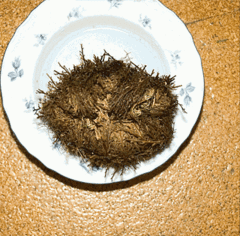| Habit | herbaceous
| |
|---|---|---|
| Height: | ⇕ | 3 in"in" can not be assigned to a declared number type with value 3. |
| Width: | ⇔ | 8 in"in" can not be assigned to a declared number type with value 8. |
| Lifespan: | ⌛ | perennial |
| Exposure: | ☼ | sun, part-sun |
|---|---|---|
| USDA Zones: | 9 to 11 |
Selaginella lepidophylla (syn. Lycopodium lepidophyllum) is a species of desert plant in the spikemoss family (Selaginellaceae). S. lepidophylla is noted for its ability to survive almost complete desiccation; during dry weather in its native habitat, its stems curl into a tight ball and uncurl when exposed to moisture.[1] It is native to the Chihuahuan Desert.
Common names for this plant include false rose of Jericho, rose of Jericho, resurrection plant, dinosaur plant, siempre viva, stone flower, and doradilla.
Selaginella lepidophylla is easily confused with Anastatica.
This plant is sold as a novelty item in its dry state, bare root. It can be revived by a little water; after wetting, the plant turns green, hence the name "resurrection plant".
Read about Selaginella lepidophylla in the Standard Cyclopedia of Horticulture
|
|---|
|
Selaginella lepidophylla, Spring. Resurrection Plant. Sts. 2-4 in. long, densely tufted, spreading in a close spiral so as to form a flattish expanse, curling closely into a ball when quite dry: lvs. of lower plane oblique, obtuse, minutely ciliated, green on the face, paler below; lvs. of upper plane nearly as long, obliquely ovate, obtuse. Texas and Mex. to Peru.—Often sold dry under the name of "resurrection plant" (which see), as the absorption of water will cause the ball with a dull brown exterior to expand and show its bright green upper face of the sts. long after the plant is dead. CH
|
Cultivation
Propagation
Pests and diseases
Varieties
Gallery
References
- ↑ Lebkuecher, J. and W. Eckmeier (June 1993,). "Physiological Benefits of Stem Curling for Resurrection Plants in the Field". Ecology 74 (4): 1073–1080.
- Standard Cyclopedia of Horticulture, by L. H. Bailey, MacMillan Co., 1963
External links
- w:Selaginella lepidophylla. Some of the material on this page may be from Wikipedia, under the Creative Commons license.
- Selaginella lepidophylla QR Code (Size 50, 100, 200, 500)
